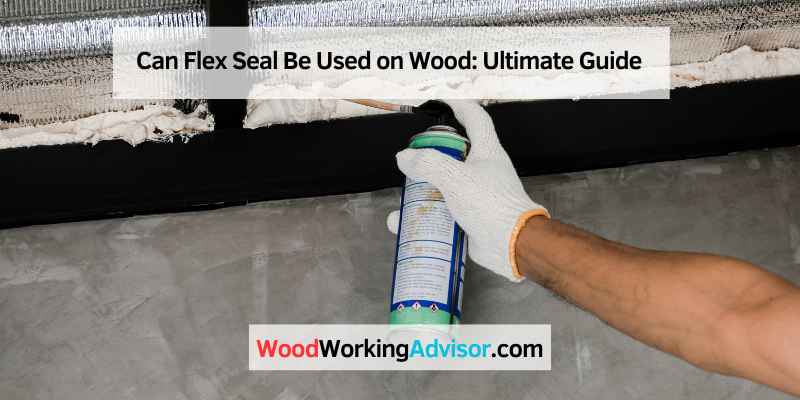Yes, Flex Seal can be used on wood to provide waterproof and UV-resistant sealing properties. It is a versatile product that can be applied to various surfaces including wood, metal, tile, concrete, fabric, glass, plastic, and more.
Flex Seal is known for its durability and longevity, lasting for years without cracking, peeling, or losing its strength. Whether you need to seal a wood fence or prevent water from coming in a window, Flex Seal proves to be an effective solution.
Its application process is similar to staining, and it can be easily applied using a foam roller or spray. With Flex Seal, you can ensure that your wood surfaces stay protected and waterproofed.
Properties Of Flex Seal
Flex Seal is a versatile product known for its exceptional sealing abilities. Its properties make it suitable for various surfaces, including wood. Whether you want to repair cracks, prevent leaks, or protect your wooden structures, Flex Seal can be an effective solution. Let’s explore the properties of Flex Seal that contribute to its effectiveness on wood.
Versatility
Flex Seal can be used on almost every surface, making it a versatile choice for sealing wood. Whether you have a wooden deck, fence, or furniture, Flex Seal can provide a protective layer. It adheres well to wood, ensuring a strong bond that can withstand various environmental factors. The versatility of Flex Seal makes it a convenient option for all your wooden sealing needs.
Durability
When applying Flex Seal on wood, you can expect long-lasting results. Flex Seal is known for its durability, meaning it can withstand the test of time. It forms a flexible rubberized barrier on the surface of the wood, preventing cracks, leaks, and other forms of damage. With proper application and maintenance, Flex Seal can last for years without losing its strength or sealing properties.
Resistance To Environmental Factors
Wooden structures are often exposed to various environmental elements, such as sunlight, moisture, and temperature changes. Flex Seal is designed to resist these factors, making it an ideal choice for wood. It is UV resistant and waterproof, ensuring that your wooden surfaces are protected from the damaging effects of the sun and water. Additionally, Flex Seal does not sag or drip in hot weather or crack and peel in cold weather, making it reliable in any season.
Overall, the properties of Flex Seal make it a suitable option for sealing wood. Its versatility, durability, and resistance to environmental factors ensure that your wooden structures remain protected for an extended period. Whether you need to repair a wooden fence, seal wooden joints, or prevent wood rot, Flex Seal can provide the solution you’re looking for.
Applying Flex Seal On Wood
Applying Flex Seal on wood provides a waterproof and durable seal. Flex Seal sticks well to wood, offering longevity without cracking or peeling, making it an ideal choice for various wood sealing applications. It can effectively prevent water damage and wood rot, enhancing the wood’s lifespan.
Surface Preparation
Before applying Flex Seal on wood, ensure the surface is clean, dry, and free of any loose particles or debris.
Inspect the wood for any cracks or gaps that need to be filled before applying Flex Seal.
Application Techniques
- Shake the Flex Seal can vigorously before use to ensure proper mixing of the formula.
- Hold the can approximately 8-12 inches away from the wood surface for optimal application.
- Apply multiple thin coats of Flex Seal rather than a single thick layer for better coverage and durability.
- Allow each coat to dry completely before applying the next one to achieve the best results.
Effectiveness Of Flex Seal On Wood
Flex Seal is a versatile product known for its sealing capabilities. When it comes to wood, Flex Seal can be a game-changer, offering a reliable solution for various issues.
Waterproofing Capabilities
Flex Seal excels in waterproofing wood surfaces, creating a protective barrier that shields against moisture damage.
Prevention Of Wood Rot
By effectively sealing wood surfaces, Flex Seal plays a crucial role in preventing wood rot, extending the lifespan of wooden structures.
Longevity Of Flex Seal On Wood
When it comes to sealing wood surfaces, the longevity of the product used is a crucial consideration. In this case, Flex Seal has gained popularity for its versatility and effectiveness. However, it is important to understand the factors that can affect the longevity of Flex Seal on wood surfaces. Additionally, hearing testimonials and success stories from other users can help provide insights into the product’s performance.
Factors Affecting Longevity
Several factors can influence how long Flex Seal lasts on wood. Understanding these factors can help ensure the best results when using this product:
- Environmental conditions: The climate and weather conditions in your area can impact the lifespan of Flex Seal on wood. Extreme temperatures, excessive humidity, and prolonged exposure to sunlight can all affect the durability of the seal.
- Number of coats applied: Applying multiple coats of Flex Seal can enhance its longevity on wood surfaces. Each additional layer helps strengthen the seal and provides added protection against moisture and other elements.
- Maintenance: Regular maintenance and upkeep can prolong the effectiveness of Flex Seal. Inspecting the sealed surface periodically and addressing any issues promptly can prevent potential damage and extend the longevity of the seal.
Testimonials And Success Stories
Hearing from others who have used Flex Seal on wood can offer valuable insights and help determine its longevity. Here are a few testimonials and success stories from Flex Seal users:
- Thrifthacker: In a YouTube video, ThriftHacker demonstrates applying Flex Seal to a wood box water fountain, showcasing the product’s effectiveness in sealing the wood surface and preventing leaks.
- Rick Rabjohn: Another YouTube video by Rick Rabjohn showcases the use of Flex Seal to seal log ends, reinforcing the wood and providing long-lasting protection against the elements.
- Discover Mid-Century: This YouTube video demonstrates repairing and sealing deck and siding using Flex Seal, highlighting the product’s durability and effectiveness on wood surfaces.
These testimonials and success stories demonstrate the effectiveness and longevity of Flex Seal on wood, providing further assurance of its sealing capabilities.
Comparing Flex Seal With Other Sealants
When it comes to protecting wood, comparing Flex Seal with other sealants can help you determine which option is best suited for your project. While traditional sealants have been widely used for wood protection, Flex Seal provides some unique advantages as well as limitations compared to specialized wood sealants.
Advantages Over Traditional Sealants
Flex Seal offers several benefits over traditional sealants when used on wood. Firstly, its versatility makes it suitable for various surfaces, including wood, metal, tile, concrete, masonry, fabric, glass, plastic, aluminum, porcelain, drywall, rubber, and cement. Moreover, its ability to resist sagging, dripping in heat, and cracking or peeling in cold temperatures makes it a reliable choice for wood protection. Additionally, Flex Seal is UV resistant and waterproof, giving it an edge over many traditional sealants when it comes to long-term durability and weather resistance.
Limitations Compared To Specialized Wood Sealants
Despite its versatility and durability, Flex Seal does have some limitations when compared to specialized wood sealants. While it can effectively prevent water damage and wood rot, specialized wood sealants may offer more targeted protection for specific wood-related issues. They may also provide enhanced aesthetic finishes and suitability for certain wood types. Furthermore, specialized wood sealants are often formulated with specific wood-related properties in mind, making them potentially more tailored to the unique needs of wooden surfaces.
Concerns And Precautions
When using Flex Seal on wood, it is important to consider certain concerns and take necessary precautions. By understanding the health and safety precautions, as well as maintenance and reapplication methods, you can ensure the effective use of Flex Seal on wood while minimizing any potential risks.
Health And Safety Precautions
Before applying Flex Seal on wood, it is imperative to prioritize health and safety. Ensure adequate ventilation when using the product, as the fumes can be strong. Additionally, it is recommended to wear protective gloves and a mask to prevent direct contact and inhalation of the product. Avoid prolonged skin exposure and wash hands thoroughly after application. Keep the product away from children and pets to prevent accidental ingestion or inhalation.
Maintenance And Reapplication
Proper maintenance and reapplication of Flex Seal on wood are essential to ensure long-lasting and effective sealing. Regularly inspect the coated wood for any signs of wear, cracking, or peeling. Reapply Flex Seal as needed to maintain its protective properties. Ensure the surface is clean and dry before reapplication to maximize adhesion and efficacy.

Frequently Asked Questions For Can Flex Seal Be Used On Wood
How Long Does Flex Seal Last On Wood?
Flex Seal can last for years on wood without cracking, peeling, or losing its strength. We recommend reapplying once the area is completely dry for optimal longevity. It works well on various surfaces and is UV resistant and waterproof, making it a great wood fence sealant.
How Well Does Flex Seal Stick To Wood?
Flex Seal effectively sticks to wood, providing a strong and long-lasting seal. It can be used for various surfaces and is resistant to weather conditions. Applying multiple coats and regular maintenance can extend its longevity.
Does Flex Seal Make Wood Waterproof?
Yes, Flex Seal makes wood waterproof by providing a layer of protection against water.
Can Flex Seal Stop Wood Rot?
Yes, Flex Seal can stop wood rot. It is a versatile product that can be used on various surfaces, including wood, to prevent water damage and rot. Many people have successfully used Flex Seal to seal and protect wood from moisture, ensuring its longevity.
Conclusion
Flex Seal has proven to be a versatile solution for various surfaces, including wood. Its ability to effectively seal and protect wood surfaces from water damage and rot makes it a top choice for many users. Flex Seal’s durability and resistance to cracking, peeling, and sagging ensure that the treated wood will last for years to come.
Whether it’s sealing a wood fence or preventing water from entering windows, Flex Seal proves to be a reliable and long-lasting solution. So, if you’re looking for a reliable wood sealant, Flex Seal is definitely worth considering.


